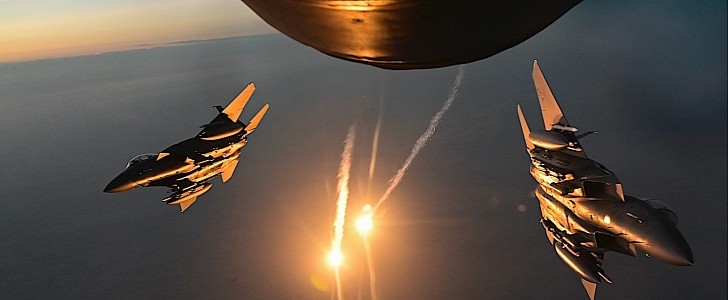Aerial refueling may seem like a complicated job for us ground-based Joes, but aviators do it routinely and are so casual about it that they mostly talk about food while their high-speed planes transfer fuel between them. But are they so used to it to set off flares when so close to each other?
If we are to judge by the image we have here, apparently so. The pic was snapped by a U.S. Air Force (USAF) staff sergeant back in early June, somewhere over the U.S. Central Command area of responsibility, meaning somewhere above dangerous places like Egypt, Iran, Iraq, Syria and Afghanistan.
We see two F-15E Strike Eagles, deployed with the 335th Fighter Squadron usually stationed at Seymour Johnson Air Force Base in North Carolina, breaking off in fighter aircraft usual fashion, one to the right and the other to the left.
Between them, flares fly, as if the two needed to badly trick some rocket or missile into not hitting them. No rocket was launched from anywhere, of course, but the planes launched flares anyway, and they did so close to a flying gas station, a KC-135 Stratotanker, assigned to the 50th Expeditionary Air Refueling Squadron.
We’re told the flares were released after the refueling process of the two planes ended, but we are not told why the pilots of the two fighter planes did it. At least, not officially.
The hard banking action we see the aircraft perform is the usual maneuver pilots use to put some distance between them and the tanker after refueling. In some cases, flares are used as a sort of thank you for an op well done.
Is it dangerous? Well, you’ve got magnesium pellets burning at 2,000 degrees Fahrenheit (1,093 Celsius), right next door to potentially 200,000 pounds (90,719 kilograms) of fuel. You do the math…
We see two F-15E Strike Eagles, deployed with the 335th Fighter Squadron usually stationed at Seymour Johnson Air Force Base in North Carolina, breaking off in fighter aircraft usual fashion, one to the right and the other to the left.
Between them, flares fly, as if the two needed to badly trick some rocket or missile into not hitting them. No rocket was launched from anywhere, of course, but the planes launched flares anyway, and they did so close to a flying gas station, a KC-135 Stratotanker, assigned to the 50th Expeditionary Air Refueling Squadron.
We’re told the flares were released after the refueling process of the two planes ended, but we are not told why the pilots of the two fighter planes did it. At least, not officially.
The hard banking action we see the aircraft perform is the usual maneuver pilots use to put some distance between them and the tanker after refueling. In some cases, flares are used as a sort of thank you for an op well done.
Is it dangerous? Well, you’ve got magnesium pellets burning at 2,000 degrees Fahrenheit (1,093 Celsius), right next door to potentially 200,000 pounds (90,719 kilograms) of fuel. You do the math…




















